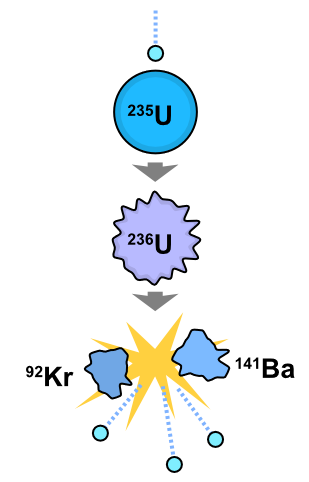Nuclear energy. Fusion and Fission
 Nuclear energy is energy obtained from the nucleus of some atoms. There are enormous amounts of energy in the bonds that hold nucleus particles together. If we break these bonds, energy is released and energy can be produced ( Fission energy ) or for some atoms, if we “fuse” atoms to form a larger atom, energy is realised ( fusion )On the left, nuclear fission ( Used in Nuclear power plants to produce electricity) and on the right a nuclear fusion ( This is how the sun produces energy)
Nuclear energy is energy obtained from the nucleus of some atoms. There are enormous amounts of energy in the bonds that hold nucleus particles together. If we break these bonds, energy is released and energy can be produced ( Fission energy ) or for some atoms, if we “fuse” atoms to form a larger atom, energy is realised ( fusion )On the left, nuclear fission ( Used in Nuclear power plants to produce electricity) and on the right a nuclear fusion ( This is how the sun produces energy)
In nuclear fission, atoms are split apart to form smaller atoms, releasing energy. In nuclear fusion, energy is released when atoms are combined together to form a larger atom.
Nuclear Fission
Above on the left there is a fission process in which an atomic nucleus (usually uranium-235 ) is broken by a neutron impact. The original heavy nucleus splits into two lighter nuclei also releasing free neutrons and an enormous quantity energy, and even gamma radiation ( the undesired collateral effect )
Some of these free neutrons may later impact against other atoms and trigger further fission events.
More fission events, more neutrons, more energy and so on. If there is no control, we are talking about an atomic bomb. So, it is necessary to have some controls about the process
This nuclear chain reaction is controlled by using “neutron stoppers “, that is neutron moderators, to control the free neutrons that will go on to cause fission energy. Let’s see a nuclear power plant.
In the above illustration there is a nuclear fission power with its fundamental elements
1st. The first and most important step for nuclear power plant operators is to manage the energy given off by the U235 enriched uranium. Its energy once, the neutron impacts against it, will allow it to heat water into steam. This process occurs in the reactor.
2nd.To prevent overheating in the reactor, control rods ( B) made of a material that absorbs neutrons may move up and down to stop the process. All of this is control using mechanisms far away from the humans.
3rd. Raising and lowering the control rods allows Nuclear Reactor Operator to control the rate of the nuclear reaction and the energy given out by the uranium. When a controller wants the uranium core to produce more energy, the control rods or control stick are raised out of the uranium bundle (more neutrons are free two break nuclei).
4th. Nuclear fission generates an extremely high-energy amount of heat, heating the water and turning it into steam.
5th. Pump F moves the water from the reactor to the Steam generator ( E).
6th. The steam from the steam generator drives a turbine, which spins a generator to produce power.
7th. I is the cooling water condenser which changes the water vapour into liquid water. F picks up liquid water and moves it to the Steam generator.
